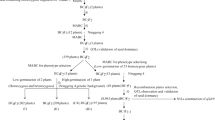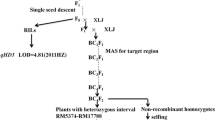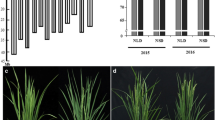Abstract
Key message
We fine-mapped a quantitative trait locus, qLG - 9, for seed longevity detected between Japonica-type and Indica-type cultivars. qLG - 9 was mapped in a 30-kb interval of the Nipponbare genome sequence.
Abstract
A quantitative trait locus, qLG-9, for seed longevity in rice has previously been detected on chromosome 9 by using backcross inbred lines derived from a cross between Japonica-type (Nipponbare) and Indica-type (Kasalath) cultivars. In the present study, the chromosomal location of qLG-9 was precisely determined by fine-scale mapping. Firstly, allelic difference in qLG-9 was verified by QTL analysis of an F2 population derived from a cross between Nipponbare and NKSL-1, in which a segment of Kasalath chromosome 9 was substituted in Nipponbare genetic background. Then, we selected F2 plants in which recombination had occurred near qLG-9 and performed F3 progeny testing on these plants to determine the genotype classes of qLG-9. Eventually, qLG-9 was mapped in a 30-kb interval (defined by two markers, CAPSb and CHPa12) of the Nipponbare genome sequence. This allowed us to nominate positional candidate genes of qLG-9. Additionally, we developed near-isogenic lines (NIL) for qLG-9 by marker-assisted selection. qLG-9 NIL showed significantly higher seed longevity than isogenic control of Nipponbare. These results will facilitate cloning of the gene(s) underlying qLG-9 as well as marker-assisted transfer of desirable genes for seed longevity improvement in rice.





Similar content being viewed by others
References
Chang TT (1991) Findings from a 28-year seed viability experiment. Int Rice Res Newsl 16:5–6
Clerkx EJM, Vries HBD, Ruys GJ, Groot SPC, Koornneef M (2004) Genetic differences in seed longevity of various Arabidopsis mutants. Physiol Plant 121:448–461
Ellis RH, Hong TD (1994) Desiccation tolerance and potential longevity of developing seeds of rice (Oryza sativa L.). Ann Bot 73:501–506
Ellis RH, Hong TD, Roberts EH (1992) The low-moisture-content limit to the negative logarithmic relation between seed longevity and moisture content in three subspecies of rice. Ann Bot 69:53–58
Garg AK, Kim JK, Owens TG, Ranwala AP, Choi YD, Kochian LV, Wu RJ (2002) Trehalose accumulation in rice plants confers high tolerance levels to different abiotic stresses. Proc Natl Acad Sci USA 99:15898–15903
Harushima Y, Yano M, Shomura A, Sato M, Shimano T, Kuboki Y, Yamamoto T, Lin SY, Antonio BA, Parco A, Kajiya H, Huang N, Yamamoto K, Nagamura Y, Kurata N, Khush GS, Sasaki T (1998) A high-density rice genetic linkage map with 2,275 markers using a single F2 population. Genetics 148:479–494
Ikehashi H (1973) Studies on the environmental and varietal differences of germination habits in rice seeds with special reference to plant breeding (in Japanese with English summary). J Cent Agric Exp Stan 19:1–60
Iordachescu M, Imai R (2008) Trehalose biosynthesis in response to abiotic stresses. J Integr Plant Biol 50:1223–1229
Jang IC, Oh SJ, Seo JS, Choi WB, Song SI, Kim CH, Kim YS, Seo HS, Choi YD, Nahm BH, Kim JK (2003) Expression of a bifunctional fusion of the Escherichia coli genes for trehalose-6-phosphate synthase and trehalose-6-phosphate phosphatase in transgenic rice plants increases trehalose accumulation and abiotic stress tolerance without stunting growth. Plant Physiol 131:516–524
Konieczny A, Ausubel FM (1993) A procedure for mapping Arabidopsis mutations using co-dominant ecotype-specific PCR-based markers. Plant J 4:403–410
Kurata N, Nagamura Y, Yamamoto K, Harushima Y, Sue N, Wu J, Antonio BA, Shomura A, Shimizu T, Lin SY, Inoue T, Fukuda A, Shimano T, Kuboki Y, Toyama T, Miyamoto Y, Kirihara T, Hayasaka K, Miyao A, Monna L, Zhong HS, Tamura Y, Wang ZX, Momma T, Umehara Y, Yano M, Sasaki T, Minobe Y (1994) A 300 kilobase interval genetic map of rice including 883 expressed sequences. Nat Genet 8:365–372
Lander ES, Green P, Abrahamson J, Barlow A, Daly MJ, Lincoln SE, Newburg L (1987) MAPMAKER: an interactive computer package for constructing primary genetic linkage maps of experimental and natural populations. Genomics 1:174–181
Landjeva S, Lohwasser U, Borner A (2010) Genetic mapping within the wheat D genome reveals QTL for germination, seed vigour and longevity, and early seedling growth. Euphytica 171:129–143
Li LF, Lin QY, Liu SJ, Liu X, Wang WY, Hang NT, Liu F, Zhao ZG, Jiang L, Wan JM (2012) Identification of quantitative trait loci for seed storability in rice (Oryza sativa L.). Plant Breed 131:739–743
McKenzie KS, Johnson CW, Tseng ST, Oster JJ, Brandon DM (1994) Breeding improved rice cultivars for temperate regions: a case study. Aust J Exp Agric 34:897–905
Miura K, Lin SY, Yano M, Nagamine T (2002) Mapping quantitative trait loci controlling seed longevity in rice (Oryza sativa L.). Theor Appl Genet 104:981–986
Murray MG, Thompson WF (1980) Rapid isolation of high molecular weight plant DNA. Nucleic Acids Res 8:4321–4325
Nagel M, Vogel H, Landjeva S, Buck-Sorlin G, Lohwasser U, Scholz U, Borner A (2009) Seed conservation in ex situ genebanks—genetic studies on longevity in barley. Euphytica 170:5–14
Obara M, Sato T, Sasaki S, Kashiba K, Nagano A, Nakamura I, Ebitani T, Yano M, Yamaya T (2004) Identification and characterization of a QTL on chromosome 2 for cytosolic glutamine synthetase content and panicle number in rice. Theor Appl Genet 110:1–11
Rao NK, Jackson MT (1996) Seed longevity of rice cultivars and strategies for their conservation in genebanks. Ann Bot 77:251–260
Rice Annotation Project Database (2014) Rice Annotation Database, Japan. http://rapdb.dna.affrc.go.jp/. Accessed May 2014
Roberts EH (1961) The viability of rice seed in relation to temperature, moisture content, and gaseous environment. Ann Bot 25:381–390
Sasaki K, Fukuta Y, Sato T (2005) Mapping of quantitative trait loci controlling seed longevity of rice (Oryza sativa L.) after various periods of seed storage. Plant Breed 124:361–366
Seshu DV, Krishnasamy V, Siddique SB (1988) Seed vigor in rice. In: Rice seed health. Proceedings of the international workshop, 16–20 March 1987, IRRI, Los Baños, Manila (Philippines): International Rice Research Institute, pp 315–329
Siddique SB, Seshu DV, Pardee WD (1988) Rice cultivar variability in tolerance for accelerated aging of seed. IRRI Res Pap Ser 131:2–7
Stein N, Prasad M, Scholz U, Thiel T, Zhang HN, Wolf M, Kota R, Varshney RK, Perovic D, Grosse I, Graner A (2007) A 1,000-loci transcript map of the barley genome: new anchoring points for integrative grass genomics. Theor Appl Genet 114:823–839
Takeuchi Y, Lin SY, Sasaki T, Yano M (2003) Fine linkage mapping enables dissection of closely linked quantitative trait loci for seed dormancy and heading in rice. Theor Appl Genet 107:1174–1180
Wang S, Basten CJ, Zeng ZB (2007) Windows QTL Cartographer ver. 2.5 Department of Statistics, North Carolina State University, Raleigh. http://statgen.ncsu.edu/qtlcart/WQTLCart.htm
Xue Y, Zhang SQ, Yao QH, Peng RH, Xiong AS, Li X, Zhu WM, Zhu YY, Zha DS (2008) Identification of quantitative trait loci for seed storability in rice (Oryza sativa L.). Euphytica 164:739–744
Yamaguchi T, Ebitani T, Omoteno M, Yamamoto Y (2007) Japanese native red rice cultivar, ‘Awa-akamai’, a genetic resource for the improvement of germination in soil at low temperatures (in Japanese with English summary). Breed Res 9:103–110
Yamauchi M, Winn T (1996) Rice seed vigor and seedling establishment in anaerobic soil. Crop Sci 36:680–686
Zeng DL, Guo LB, Xu YB, Yasukumi K, Zhu LH, Qian Q (2006) QTL analysis of seed storability in rice. Plant Breed 125:57–60
Acknowledgments
This work was supported in part by a Grant-in-Aid from the Ministry of Agriculture, Forestry and Fisheries, Japan (Green Technology Project QT-2008 and Genomics for Agricultural Innovation, QTL-4009). K. Sasaki was a recipient of a Research Fellowship for Young Scientists from the Japan Society for the Promotion of Science (18-5156). Grateful acknowledgement is extended to Dr. K. Sugimoto and Mr. T. Shimizu (National Institute of Agrobiological Sciences), Dr. M. Obara (Japan International Research Centre for Agricultural Sciences) and Ms. E. Hanzawa (Tohoku University) for their helpful suggestions in analyzing the data.
Conflict of interest
The authors declare that they have no conflict of interest.
Ethical standard
The experiments comply with the current laws of the country in which they were performed.
Author information
Authors and Affiliations
Corresponding author
Additional information
Communicated by L. Jiang.
Electronic supplementary material
Below is the link to the electronic supplementary material.
Rights and permissions
About this article
Cite this article
Sasaki, K., Takeuchi, Y., Miura, K. et al. Fine mapping of a major quantitative trait locus, qLG-9, that controls seed longevity in rice (Oryza sativa L.). Theor Appl Genet 128, 769–778 (2015). https://doi.org/10.1007/s00122-015-2471-7
Received:
Accepted:
Published:
Issue Date:
DOI: https://doi.org/10.1007/s00122-015-2471-7




